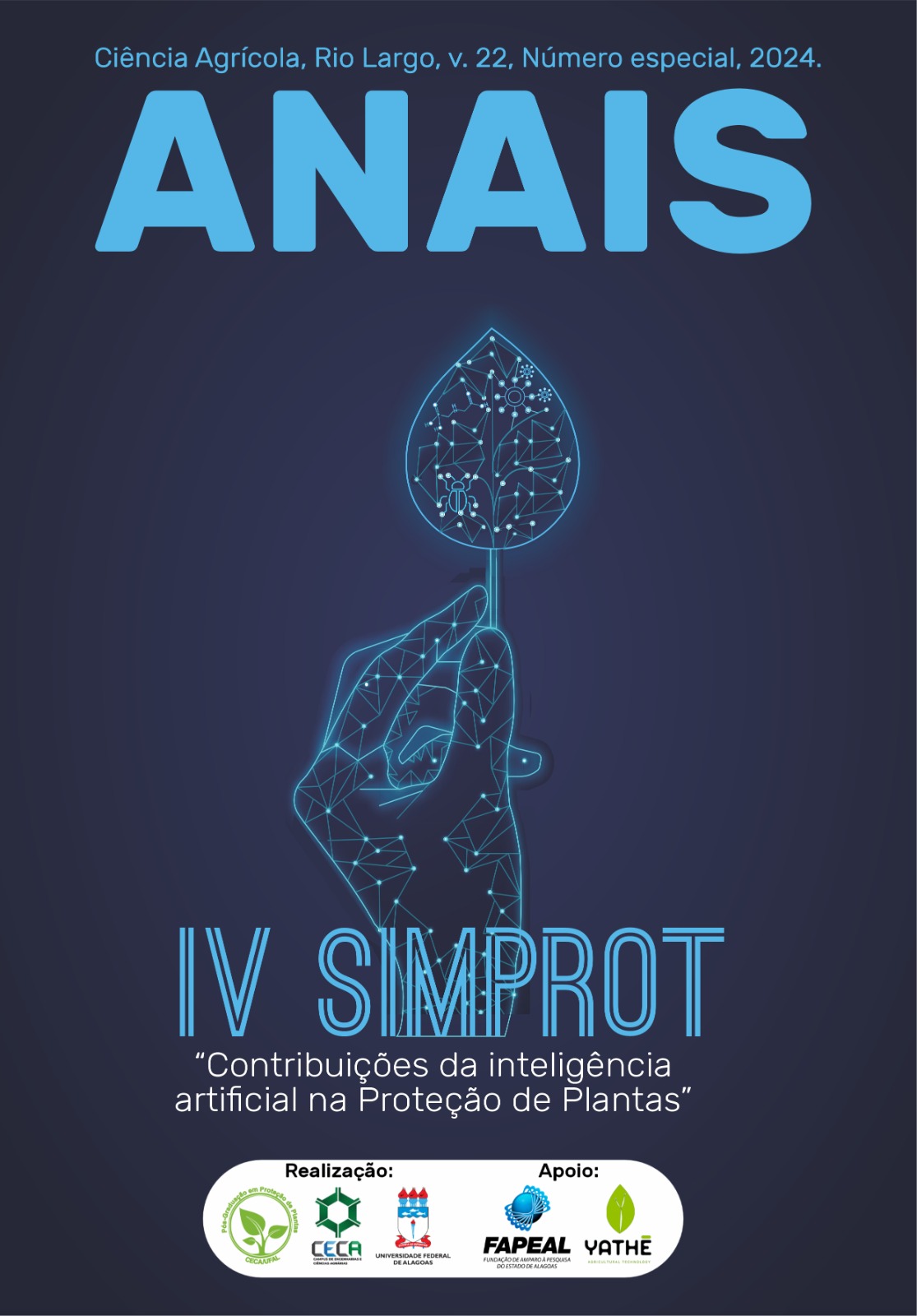FEASIBILITY OF DIETS FOR BREEDING Atheloca bondari HEINRICH (LEPIDOPTERA: PYRALIDAE)
DOI:
https://doi.org/10.28998/rca.22.18605Keywords:
Coconut Moth, Insect farm, coconut pestsAbstract
The coconut tree (Cocos nucifera L.) is a crop of great importance, being planted on almost all continents. In addition to natural problems and incorrect management, the occurrence of insect pests is a challenge for production. Atheloca bondari (coconut moth) is a microlepdopteran that in its young phase feeds on young fruits and can lead to abortion, where currently the only control method used is preventive. With the need for efficient control methods, there is also a need for stabilized creation in the laboratory, so that more research can be carried out. In this context, the present work aimed to develop and adapt a breeding methodology for A. bondari, using artificial and natural diets for multiplication in the laboratory. To this end, the viability of A. bondari caterpillars on different diets was evaluated. The research was carried out in a BOD chamber at 25±1ºC, relative humidity of 70±10% and a 12-hour photoperiod, allocated and made available by the Agricultural and Forestry Entomology Laboratory – LEAF. For the bioassay, a completely randomized design was used, with 20 replications for each treatment, totaling 80 experimental units. The following treatments were used: Natural diet 1 (fragmented coconut), Natural diet 2 (whole new coconut), Artificial diet 1 (coconut-based) and Artificial diet 2 (bean-based). Assessments were carried out weekly. The results were subjected to analysis of variance and the means were compared using the T test at 5% probability. The results obtained show that the Natural 1 and Artificial 1 diets were equally efficient. Therefore, it is concluded that it is possible to create A. bondari in the laboratory using a natural and artificial diet.
Downloads
References
Agrofit. Sistemas de agrotóxicos fitossanitários. 2023. Disponível em: http://extranet.agricultura.gov.br/agrofit_cons/principal_agrofit_cons.
Chalfant, R B. A simplified technique for rearing the lesser cornstalk borer (Lepidoptera: Phycitidae). J. Georgia Entomol. Soc. 1975, 10:33-37.
D'almeida J. M., Oliveira V. C.. Dietas artificiais para a criação, em laboratório, de Chrysomya (C. megacephala, C.albiceps e C. putoria) (Diptera: Calliphoridae). Entomol Vect, 2002, 9, 79-91.
Fao (Roma). List ot insect pesta of coconut palm, In: Session Technicalworking Party On Coconut Production. Protection And Processing. 2. 1964, Colombo, Sri Lanka, Paper. Roma, 1964, 17p.
Faostat - Food And Agriculture Organization Of The United Nations, 2021.
Ferreira, J. M. S.; Warwick, D. R. N.; Siqueira, L. A. (Ed.). A cultura do coqueiro no Brasil. 2. ed. rev. amp! Brasilia: Embrapa-SPI;Araeaju: Embrapa-CPATC, 1998. 292 p. il.
Harries, H. Farm and Forestry Production and Marketing Profile for Coconut (Cocos nucifera). In: ELEVITCH, C. R. (Ed.). Specialty Crops for Pacific Island Agroforestry, Holualoa, Hawai‘i: Permanent Agriculture Resources (PAR), 2009.
Instituto Brasileiro de Geografia e Estatística-IBGE. Produção agrícola municipal – Série novembro de 2021.
Lima, H. M. A. Criação de Rhyncophorus palmarum (Linnaeus, 1758) (Coleoptera: Curculionidae) em dietas artificiais e controle utilizando fungos entomopatogênicos. 2014. Tese (Doutorado em proteção de plantas) - Universidade Federal de Alagoas, Rio Largo, 2014.
Martins, C. R., Jesus Júnior, L. A. DE. Produção e comercialização de coco no Brasil frente ao comércio internacional: panorama 2014. Aracaju. Embrapa Tabuleiros Costeiros, 2014. 51 p.
Negrisole Junior, A.S. et al. Criação em laboratório da broca-do-olho-do-coqueiro Rhynchophorus palmarum L. (Coleoptera: Curculionidae) visando pesquisas para o controle das suas larvas. Comunicado Técnico – EMBRAPA, Aracaju, SE, dezembro, 2011. n.116.
Parra, J. R. P. A evolução das dietas artificiais e suas interações em ciência e tecnologia. In: Panizzi, A.R.; Parra, J.R.P. (Eds.). Bioecologia e nutrição de insetos – base para o manejo integrado de pragas. Brasília: Embrapa, 2009, 91-174.
Santana, S.W. J. S. et al. Exigências térmicas da praga do coqueiro Atheloca subrufella (Hulst) (Lepidoptera: Phycitidae). Neotropical Entomology, 2010, 39, 181-186.
Sánchez, P. A. et al. Biology and behaviour of Rhynchophorus palmarum. Boletín de Entomología Venezolana, 1993, 8, 83–93.
Singh P, Moore R F. Handbook of insects rearing. Elsevier Science Publishing, Amsterdam. 1985, 600p.
Downloads
Published
Issue
Section
License
Copyright (c) 2024 Rayanne Vieira

This work is licensed under a Creative Commons Attribution 4.0 International License.
Termo de cessão de direitos autorias
Esta é uma revista de acesso livre, em que, utiliza o termo de cessão seguindo a lei nº 9.610/1998, que altera, atualiza e consolida a legislação sobre direitos autorais no Brasil.
O(s) autor(es) doravante designado(s) CEDENTE, por meio desta, cede o direito de primeira publicação da OBRA à Revista Ciência Agricola, representada pelo Centro de Ciência Agrarias da Universidade Federal de Alagoas, estabelecida na BR 104 Norte, Km 35, Rio Largo, Alagoas, CEP 57100-000 doravante designada CESSIONÁRIA, nas condições descritas a seguir:
O CEDENTE declara que é (são) autor(es) e titular(es) da propriedade dos direitos autorais da OBRA submetida.
O CEDENTE declara que a OBRA não infringe direitos autorais e/ou outros direitos de propriedade de terceiros, que a divulgação de imagens (caso as mesmas existam) foi autorizada e que assume integral responsabilidade moral e/ou patrimonial, pelo seu conteúdo, perante terceiros
O CEDENTE mantêm os direitos autorais e concedem à revista o direito de primeira publicação, com o trabalho simultaneamente licenciado sob a Licença Creative Commons do tipo atribuição CC-BY, para todo o conteúdo do periódico, exceto onde estiver identificado, que permite o compartilhamento do trabalho com reconhecimento da autoria e publicação inicial nesta revista, sem fins comerciais.
O CEDENTE têm autorização para distribuição não-exclusiva da versão do trabalho publicada nesta revista (ex.: publicar como capítulo de livro), com reconhecimento de autoria e publicação inicial nesta revista.
O CEDENTE têm permissão e são estimulados a publicar e distribuir seu trabalho online (ex.: em repositórios institucionais ou na sua página pessoal), já que isso pode gerar alterações produtivas, bem como aumentar o impacto e a citação do trabalho publicado.




